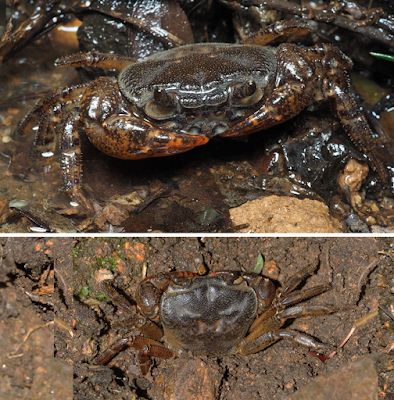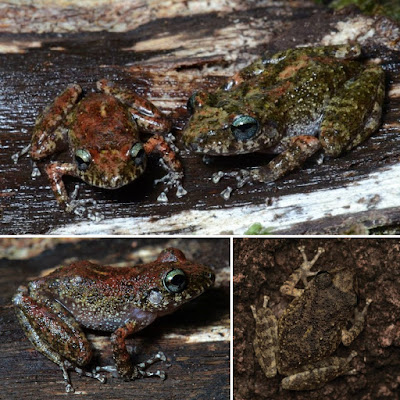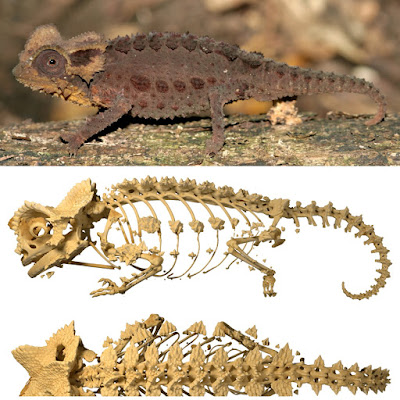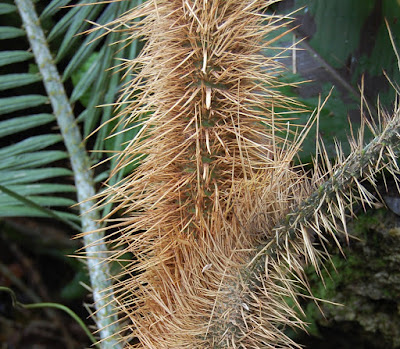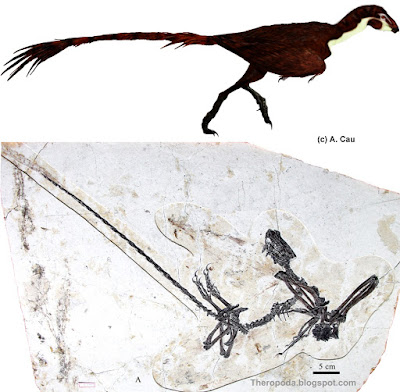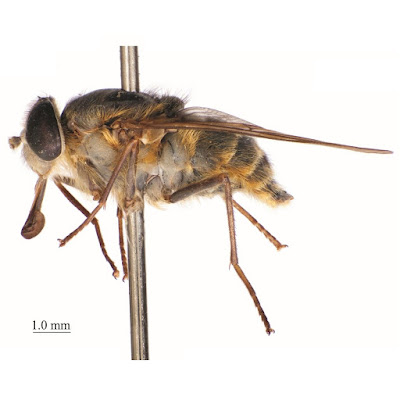[Most Recent Entries] [Calendar View]
Monday, May 25th, 2020
| Time | Event | ||||||
| 6:02a | [Crustacea • 2020] Qianguimon yuzhouense • A New Species of Freshwater Crab of the Genus Qianguimon Huang, 2018 (Decapoda: Brachyura: Potamidae) from Guangxi, Southern China
Abstract A new species of freshwater crab of the genus Qianguimon Huang, 2018, is described from Guangxi Zhuang Autonomous Region, southern China. It can be distinguished from congeners by the following characters: male first gonopods bent inward at about 45° at base of terminal segment, carapace regions distinct and rugged and the female vulva opening inwards and downwards. In addition, molecular evidence derived from the 16S rRNA gene supported the species described in this study as a new species of Qianguimon. Systematics Family Potamidae Ortmann, 1896Qianguimon Huang, 2018 Qianguimon yuzhouense n. sp. Diagnosis. Carapace broader than long, regions distinct, anterolateral regions rugose; cervical groove and H-shaped groove deep, distinct; epigastric cristae conspicuous, postorbital cristae sharp. External orbital angle narrowly triangular, separated from anterolateral margin by gap; epibranchial teeth distinct; anterolateral margin lined with conspicuous granules. Third maxilliped merus median depression indistinct, exopod with vestigial flagellum. Chelipeds slightly unequal; outer surfaces of chelae smooth; fingers with very small gap when closed. Male pleon narrowly triangular, lateral margins gently concave; telson triangular, somite 6 transversely trapeziform. Male sterno-pleonal cavity very deep, median longitudinal suture of sternites 7/8 deep and relatively long. G1 very slender, terminal segment boot-shaped, distinctly sinuous, tip of terminal segment exceeding sternites 4/5 suture. Female vulva reaching sternites 5/6 suture, with opening directed inward at an angle of 45°.  Etymology. The new species is named after the type locality, Yuzhou District, Yulin City, Guangxi Zhuang Autonomous Region, China. Ecology. This species was found in a stream next to a mountain road. The stream has no obvious flowing water, and has lush weeds growing in it. We found the crab burrows by removing the weeds. The burrows are sandy and without much soil. We found the crabs after digging about 10 cm into the burrows (Figs. 6C and 6D). Conclusions: In this article, we reported a new species of freshwater crab from Yuzhou District, Yulin City, Guangxi Zhuang Autonomous Region, China. We found that it fits well within the definition of Qianguimon Huang, 2018, morphologically, and our molecular analysis also supports it as a new species of the genus Qianguimon.Song-Bo Wang, Ya-Nan Zhang and Jie-Xin Zou. 2020. A New Species of Freshwater Crab of the Genus Qianguimon Huang, 2018 (Decapoda: Brachyura: Potamidae) from Guangxi, Southern China. PeerJ. 8:e9194. DOI: 10.7717/peerj.9194 | ||||||
| 6:25a | [Herpetology • 2020] Pristimantis rupicola • A New Rupicolous Species of the Pristimantis conspicillatus Group (Anura: Craugastoridae) from Central Bahia, Brazil
Abstract We describe a new frog species of the megadiverse genus Pristimantis from the Chapada Diamantina, a regional designation of the Espinhaço mountain range in the state of Bahia, northeastern Brazil. We assign the new species to the genus Pristimantis, P. conspicillatus group, based on its phylogenetic position. This is the second rupicolous species of Pristimantis and the fourth species inhabiting northeastern Brazil. The new species is characterized by the following combination of characters: 1) dorsum background color light brown to yellowish-brown, maculated with blackish-brown marks, resembling a granite rock surface; 2) dorsum granular; 3) venter areolate; 4) dentigerous process of the vomer ovoid; 5) snout rounded or truncate in dorsal view; 6) snout rounded in profile; 7) dorsolateral folds absent; 8) finger fringes absent; 9) toe fringes weakly developed; 10) double, poorly developed nuptial pads; 11) vocal slits present in the male; 12) advertisement call composed of one note; 13) call duration 0.011–0.086 s; 14) dominant frequency varying from 2.41 to 3.49 kHz; and 15) decreasing amplitude modulation from the beginning to the end of call. We recovered the new species outside the clade containing the other three nominal species of Pristimantis from northeastern Brazil, as the sister species of P. gaigei, a species from Costa Rica, Panama, and Colombia. The new species seems to be restricted to the high-elevation areas (870–1,800 m a.s.l.) of the Chapada Diamantina, Central Bahia, Brazil. Both the genus Pristimantis and the P. conspicillatus group still lack morphological synapomorphies, and a thorough systematic review based on a stringent phylogenetic hypothesis is necessary for a better understanding of the evolution of these important lineages of Neotropical frogs.
Pristimantis rupicola sp. nov. Etymology.— The specific name is derived from the Latin ‘‘rupes,’’ ‘‘rupis,’’ meaning rock, and ‘‘cola,’’ meaning dweller. The name is used in reference to the habits of the new species, which is commonly found among rocks of the Campo Rupestre environment of the Chapada Diamantina. Distribution.— Pristimantis rupicola sp. nov. occurs in the highlands of the Chapada Diamantina, state of Bahia, Brazil, from ~870 to almost 1,800 m of elevation, in the municipalities of Ipupiara, Piatã, and Rio de Contas (Fig. 5). Pedro P. G. Taucce, Jamile S. Nascimento, Camila C. Trevisan, Felipe S. F. Leite, Diego J. Santana, Célio F. B. Haddad and Marcelo F. Napoli. 2020. A New Rupicolous Species of the Pristimantis conspicillatus Group (Anura: Brachycephaloidea: Craugastoridae) from Central Bahia, Brazil. J. of Herpetology. 54(2); 245-257. DOI: 10.1670/19-114 | ||||||
| 6:42a | [Herpetology • 2020] Brookesia perarmata • Armored with Skin and Bone: A Combined Histological and μCT‐Study of the Exceptional Integument of the Antsingy Leaf Chameleon
Abstract Madagascar's endemic ground‐dwelling leaf chameleons (Brookesiinae: Brookesia Gray, 1865 + Palleon Glaw, et al., Salamandra, 2013, 49, pp. 237–238) form the sister taxon to all other chameleons (i.e., the Chamaeleoninae). They possess a limited ability of color change, a rather dull coloration, and a nonprehensile tail assisting locomotion in the leaf litter on the forest floor. Most Brookesia species can readily be recognized by peculiar spiky dorsolateral projections (“Rückensäge”), which are caused by an aberrant vertebral structure and might function as body armor to prevent predation. In addition to a pronounced Rückensäge, the Antsingy leaf chameleon Brookesia perarmata (Angel, 1933) exhibits conspicuous, acuminate tubercle scales on the lateral flanks and extremities, thereby considerably enhancing the overall armored appearance. Such structures are exceptional within the Chamaeleonidae and despite an appreciable interest in the integument of chameleons in general, the morphology of these integumentary elements remains shrouded in mystery. Using various conventional and petrographic histological approaches combined with μCT‐imaging, we reveal that the tubercle scales consist of osseous, multicusped cores that are embedded within the dermis. Based on this, they consequently can be interpreted as osteoderms, which to the best of our knowledge is the first record of such for the entire Chamaeleonidae and only the second one for the entire clade Iguania. The combination of certain aspects of tissue composition (especially the presence of large, interconnected, and marrow‐filled cavities) together with the precise location within the dermis (being completely enveloped by the stratum superficiale ), however, discriminate the osteoderms of B. perarmata from those known for all other lepidosaurs. Keywords: 3D morphology, Brookesiinae, Chamaeleonidae, histology, integument, osteoderm Pia J. Schucht, Peter T. Rühr, Benedikt Geier, Frank Glaw and Markus Lambertz. 2020. Armored with Skin and Bone: A Combined Histological and μCT‐Study of the Exceptional Integument of the Antsingy Leaf Chameleon Brookesia perarmata (Angel, 1933). Journal of Morphology. DOI: 10.1002/jmor.21135 | ||||||
| 6:58a | [Herpetology • 2020] Systematic Revision of the Rare Bromeligenous Genus Crossodactylodes Cochran 1938 (Anura: Leptodactylidae: Paratelmatobiinae)
Abstract Crossodactylodes is a poorly known genus of small-sized bromeligenous frogs, endemic to Brazil. They have a patchy distribution across the mountains of the Atlantic Forest and the “campo rupestre” ecosystem. To better resolve their evolutionary relationships, we performed phylogenetic analyses using a multigene DNA matrix and representative sampling within the genus. We then evaluated the evolution of phenotypical and natural history traits with the inferred phylogeny. We recovered Crossodactylodes as monophyletic, diagnosed by seven putative synapomorphies in morphological and natural history characters. Evidence supports some morphological synapomorphies as adaptations to the bromeligenous habit. We found high genetic distances among closely distributed lineages within C. bokermanni and C. izecksohni. Some of these lineages might represent undescribed cryptic species. We provide detailed accounts for each species including data on their geographic range, conservation, and natural history. All species of Crossodactylodes occur in highly threatened environments, are restricted to very small geographic ranges, and probably have limited dispersal capacity due to their small body size and dependence on bromeliads. These factors emphasize the need for habitat protection to safeguard species viability. KEYWORDS: Atlantic forest, campo rupestre, character evolution, Endemism, Molecular phylogenetics, taxonomic revision Crossodactylodes pintoi Cochran, 1938 Crossodactylodes bokermanni Peixoto, 1983 Crossodactylodes izecksohni Peixoto, 1983 Crossodactylodes itambe Barata, Santos, Leite & Garcias, 2013 Crossodactylodes septentrionalis Teixeira, Recoder, Amaro, Damasceno, Cassimiro & Rodrigues, 2013 Marcus Thadeu T. Santos, Rafael F. Magalhães, Rodrigo B. Ferreira, Stenio E. Vittorazzi, Iuri R. Dias, Felipe S. F. Leite, Luciana B. Lourenço, Fabrício R. Santos, Célio F. B. Haddad and Paulo C. A. Garcia. 2020. Systematic Revision of the Rare Bromeligenous Genus Crossodactylodes Cochran 1938 (Anura: Leptodactylidae: Paratelmatobiinae). Herpetological Monographs. 34(1); 1-38. DOI: 10.1655/HERPMONOGRAPHS-D-19-00008.1 | ||||||
| 7:11a | [Botany • 2020] A Revision of Attalea (Arecaceae, Arecoideae, Cocoseae, Attaleinae)
Abstract A taxonomic revision of the neotropical palm genus Attalea based on morphological data was carried out. Nine hundred and two herbarium specimens were scored for 21 quantitative and 33 qualitative variables. Using the Phylogenetic Species Concept, qualitative variables were used to recognize 30 species. These are widely distributed in Central and South America from Mexico to Bolivia and Paraguay, with one species in Haiti. Nomenclature, descriptions, and distribution maps are provided for each species. Qualitative variables are illustrated, and illustrations of 22 living plants are also provided. Keywords: Maximiliana, Neotropics, Orbignya, Palmae, Scheelea, Monocots  Attalea butyracea (Mutis ex L. f.) Wess. Boer Andrew Henderson. 2020. A Revision of Attalea (Arecaceae, Arecoideae, Cocoseae, Attaleinae). Phytotaxa. 444(1); 1-76. DOI: 10.11646/phytotaxa.444.1.1 | ||||||
| 7:20a | [Botany • 2020] A Revision of Calamus (Arecaceae, Calamoideae, Calameae, Calaminae)
Abstract A revision of Calamus was carried out based on morphological data. Eight thousand, six hundred and thirty-three herbarium specimens were examined and scored for 14 quantitative and 157 qualitative variables. Application of the Phylogenetic Species Concept to 516 preliminary species of Calamus resulted in recognition of 411 phylogenetic species. Of these, 38 are recognized as new (C. barisanensis, C. brevissimus, C. brunneus, C. calciphilus, C. densifloropsis, C. disjunctus, C. divergens, C. exiguus, C. furvus, C. gaharuensis, C. goramensis, C. heteracanthopsis, C. hosensis, C. impressus, C. insolitus, C. insularis, C. johanis, C. kinabaluensis, C. kubahensis, C. latus, C. lengguanii, C. lobatus, C. notabilis, C. obiensis, C. oresbiopsis, C. oxleyoides, C. pahangensis, C. powlingii, C. saltuensis, C. seropakensis, C. spinosus, C. sulawesiensis, C. tambingensis, C. tapanensis, C. trigynus, C. vinaceus, C. viridis, C. wedaensis). Analysis of quantitative variables and geographic distributions resulted in the division of 11 species into 36 subspecies. Eight species were considered to be ochlospecies (C. erioacanthus, C. inermis, C. javensis, C. melanochaetes, C. micranthus, C. moseleyanus, C. plicatus, C. siphonospathus). Nomenclature, descriptions, and distribution maps are provided for all species. Images of the type specimens of all new species are provided as well as images of most qualitative variables. One hundred and forty–three species are illustrated with images from living plants. Keywords: Palmae, rattans, morphology, systematics, phylogenetic species, Daemonorops, Ceratolobus, Pogonotium Andrew Henderson. 2020. A Revision of Calamus (Arecaceae, Calamoideae, Calameae, Calaminae). Phytotaxa. 445(1); 1-656. DOI: 10.11646/phytotaxa.445.1.1 | ||||||
| 7:51a | [Paleontology • 2020] Kompsornis longicaudus • A New Jeholornithiform exhibits the Earliest Appearance of the Fused Sternum and Pelvis in the Evolution of Avialan Dinosaurs
Highlights: • A new genus of Jeholornithiformes from the Jehol Biota in China. • The earliest occurrence of fused pelvis during the evolution from non-avian dinosaurs to birds. • The skeletal reinforcement occurred during the juvenile ontogeny in some Jeholornithiformes. Abstract A new jeholornithiform - Kompsornis longicaudus gen. et sp. nov. - is reported based on a nearly complete specimen from the Jehol Biota in western Liaoning, China. Comprehensive comparisons and phylogenetic analysis, including all published species of Jeholornithiformes, are provided and indicate that Shenzhouraptor sinensis, Jeholornis prima, Jixiangornis orientalis, Jeholornis palmapenis and Jeholornis curvipes are all valid species of this clade, but that Dalianraptor cuhe is regarded as a nomen dubium. In particular, K. longicaudus possesses completely fused sternum and pelvis, a combination of advanced features that is for the first time recognized among jeholornithiforms and non-pygostylian avialans. The osteohistological investigation suggests that the skeletal reinforcement occurred during the juvenile ontogeny in some Jeholornithiformes. Therefore, the new discovery further enriches the diversity of Jeholornithiformes and suggests an unexpected developmental disparity in ossification patterns along the lineage from non-avian dinosaurs to birds. Keywords: Early Cretaceous, Jehol Biota, Jeholornithiformes, osteohistology, taxonomy
Dinosauria Owen, 1842 Theropoda sensu Gauthier, 1986 Maniraptora Gauthier, 1986 Avialae Gauthier, 1986 Jeholornithiformes Zhou and Zhang, 2006 Genus Kompsornis gen. nov. Etymology. Kompsornis is composed of the Greek ‘Kompsos’ (elegant or pretty) and ‘ornis’ (bird). Kompsornis longicaudus sp. nov. Etymology. The term longicaudus is composed of Latin ‘longis’ (elongated) and ‘caudus’ (tail), referring to the relatively long tail vertebrae of the type specimen. Type locality and horizon. Jiufotang Formation, Lingyuan locality, western Liaoning, China. Xuri Wang, Jiandong Huang, Martin Kundrát, Andrea Cau, Xiaoyu Liu, Yang Wang and Shubin Ju. 2020. A New Jeholornithiform exhibits the Earliest Appearance of the Fused Sternum and Pelvis in the Evolution of Avialan Dinosaurs. Journal of Asian Earth Sciences. In Press, 104401. DOI: 10.1016/j.jseaes.2020.104401 | ||||||
| 8:26a | [Herpetology • 2012] Anzomyia gen. nov. • A New Genus of Australian and New Zealand Horse Fly (Diptera: Tabanidae: Pangoniinae), including the Description of Three New Species
Abstract A new genus of Australian and New Zealand horse fly, Anzomyia Lessard, gen.n., is described, with its type species Anzomyia anomala (Mackerras) originally placed in the Scaptia (Walker, 1850) subgenus Pseudoscione (Lutz, 1918). The new genus Anzomyia is diagnosed and illustrated, along with the description of three new species. A taxonomic key is also provided to include all known species. The three new species are Anzomyia chrysomallis Lessard, sp.n. and Anzomyia pegasus Lessard, sp.n. from Australia, and Anzomyia herculensis Lessard, sp.n. from New Zealand. Keywords: Scaptia; Pseudoscione; Copidapha; anomala; descriptive taxonomy; morphology Systematics Family: Tabanidae Subfamily: Pangoniinae Tribe: Scionini Genus: Anzomyia Lessard, gen.n. Etymology: The name is derived from the Greek myia, fly, combined with the Australian and New Zealand distribution of the genus. Species included: Anzomyia anomala (Mackerras); Anzomyia chrysomallis Lessard, sp.n.; Anzomyia herculensis Lessard, sp.n.; Anzomyia pegasus Lessard, sp.n. Anzomyia chrysomallis Lessard, sp.n. Etymology: This specific epithet is derived from the Greek chrysos, gold, and mallos, wool, and refers to the distinct golden yellow hairs covering the species. Anzomyia pegasus Lessard, sp.n. Etymology: This specific epithet is a latinised derivation of the winged horse Pegasos from Greek mythology, and refers to the projecting face of the species resembling the elongated nose of a horse. Anzomyia herculensis Lessard, sp.n. Etymology: This specific epithet refers to the type locality, Mt Hercules in New Zealand. Bryan D. Lessard and David K. Yeates. 2012. Anzomyia (Diptera: Tabanidae: Pangoniinae: Scionini): A New Genus of Australian and New Zealand Horse Fly, including the Description of Three New Species. Insect Systematics & Evolution. 43(2); 101–116. DOI: 10.1163/187631212X637526 |
| << Previous Day |
2020/05/25 [Calendar] |
Next Day >> |
